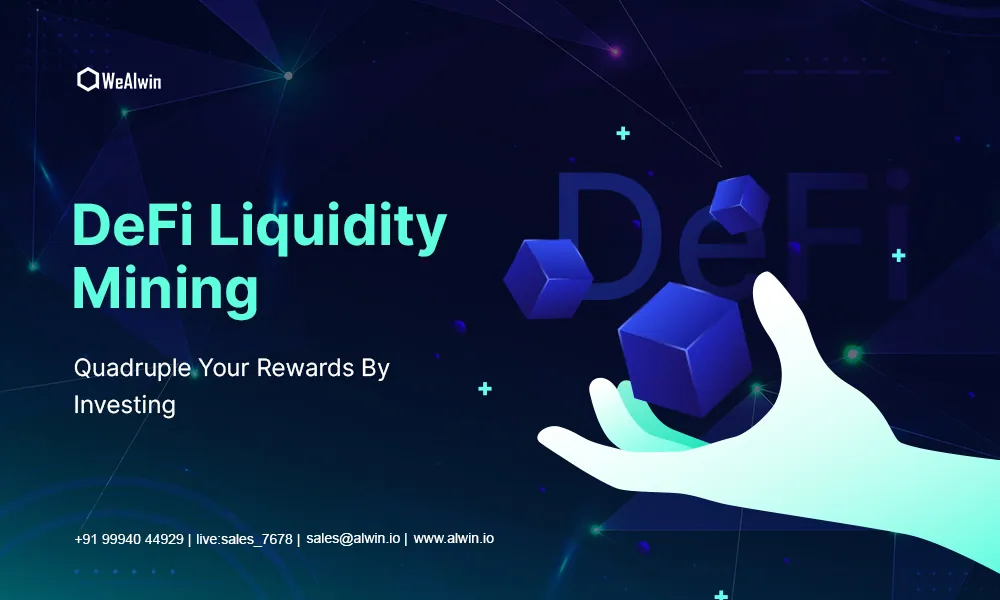Decentralized Financial ecosystem that knows no borders, operates 24/7 and puts the power of wealth creation squarely in the hands of individuals.
Welcome to the world of DeFi liquidity mining💎, where the boundaries of traditional finance are pushed to their limits, and profit opportunities 💰 are as boundless as the blockchain itself.
We explore the dynamic interplay between liquidity providers and decentralized platforms, where participants are not just investors but active contributors to a financial revolution.
Get ready to dive deep into liquidity mining, which seizes the limitless possibilities🙌 that await in the realm of decentralized finance.
What is DeFi Mining?
DeFi mining, often called liquidity mining or yield farming, is a decentralized finance (DeFi) strategy where users contribute assets to blockchain protocols in exchange for rewards. These rewards typically include trading fees, interest, or governance tokens.
Unlike traditional mining (e.g., Bitcoin’s Proof of Work), DeFi mining doesn’t require computational power. Instead, it relies on liquidity provision or staking to support DeFi platforms like decentralized exchanges (DEXs) or lending protocols.
The core idea is to incentivize users to lock their crypto assets into smart contracts, enabling protocols to function efficiently. For example, Compound kickstarted this trend in 2020 by distributing COMP tokens to liquidity providers, creating a flywheel effect that boosted platform adoption.
Types of DeFi Mining
1. Liquidity Mining
Liquidity mining involves depositing paired assets (e.g., ETH/USDC) into a DEX’s liquidity pool. In return, users earn a share of trading fees and often receive governance tokens like SUSHI or UNI.
For instance:
- Uniswap: Users deposit tokens into pools and earn fees (0.3% per trade).
- SushiSwap: Offers "super pools" with higher rewards for staking platform-native tokens (e.g., SUSHI/USDC).
2. Yield Farming
Yield farming is a broader strategy where users optimize returns by moving assets across multiple protocols.
This includes:
- Staking: Locking tokens to secure networks (e.g., Ethereum 2.0) or earn interest (e.g., Lido’s stETH).
- Lending/Borrowing: Platforms like Aave and Compound reward users with interest and governance tokens.
- Restaking: Emerging in 2024, protocols like EigenLayer let users restake ETH to secure additional services (e.g., oracles, Layer-2s) for compounded rewards.
Benefits of Liquidity Mining:
Now that we know what liquidity mining is, let's look at the advantages of using this investment approach. When you contribute assets to liquidity pools, you may be aware of the returns on your investment. The key benefits of DeFi liquidity mining are as follows:
1. passive Income
2. The potential for high yields
3. Governance and native token distribution
4. Low entry barrier
5. Creating a trustworthy and loyal community
Passive Income:
Liquidity mining simply needs a few crypto assets to be locked up in a protocol to get started. The protocol creates income as it interacts with users, and this income is transferred to investors as a reward. It's also critical to remember that the amount of liquidity you have contributed will determine how much of the return you receive.
High Yield:
Before you start participating in liquidity mining, you need to understand that your yield is proportionate to the entire risk you incur with your investment, making liquidity mining a good strategy for any sort of investor. If you make a significant commitment, the returns will be proportionate to your contribution. The same is true if you wish to test the waters before completely committing to the liquidity mining technique.
Distribution of Native and Governance Tokens:
Unlike other miners, liquidity miners have the exclusive opportunity to receive a portion of the protocol's native and governance tokens for free. Holders of the governance token have voting rights over the protocol. People frequently keep governance tokens for a long time because of this advantage.
Low Entry Barrier:
Although alternative DeFi techniques may provide better yield options than liquidity mining, liquidity mining has the lowest entry-level complexity. Anyone can now more easily access financial products that provide passive income thanks to liquidity mining.
Helps in Building A Community:
Liquidity Mining aids in creating a community by creating a network of dependable and devoted neighbors. This community would consist of users of the protocol, token holders for the protocol, and investors who locked their cryptocurrency assets in the protocol. Although other factors contribute to community growth, liquidity is an important one for fostering communities.
How Does DeFi Liquidity Mining Work?
Liquidity mining is a process in which crypto holders lend assets to a decentralized exchange in return for rewards. These rewards commonly stem from trading fees that are accrued from traders swapping tokens.
Fees average 0.3% per swap and the total reward differs based on one's proportional share in a liquidity pool. Liquidity mining is a passive income method that helps crypto holders profit by utilizing their existing assets rather than leaving them inactive in cold storage.
To participate in liquidity mining, participants provide some of their cryptocurrency assets into various liquidity pools. By depositing their assets into the DeFi platforms, liquidity providers (LPs) make it easier for traders to get into and out of positions, with the trading fees partly used to reward them.
The more LP contributes to a liquidity pool, the greater the share of rewards they will receive. Different platforms have varying implementations, but this is the basic idea behind liquidity mining.
Liquidity mining has become an essential aspect of the DeFi ecosystem, as it provides liquidity to decentralized exchanges, allowing traders to trade their assets without the need for a centralized intermediary.
Step-by-Step Guide to Start DeFi Mining
1. Set Up a Wallet
Use a non-custodial wallet like MetaMask or Ledger to maintain control of your assets.
2. Choose a Platform
Research platforms using tools like Nansen or DeFiLlama to compare APYs and audit status.
Example: Start with a stablecoin pool on Curve to minimize impermanent loss.
3. Deposit Funds
For liquidity mining: Deposit equal values of two tokens (e.g., 50% ETH, 50% USDC) into a pool.
For yield farming: Lend assets on Aave or stake ETH on Lido.
4. Stake LP Tokens
After depositing, stake your LP tokens (e.g., UNI-V2 LP) into a mining contract to earn additional rewards.
5. Monitor and Optimize
Use dashboards like Zapper.fi to track returns.
Reinvest rewards into higher-yield pools or exit if APYs drop due to overcrowding.
Does DeFi Liquidity Mining have Risk?
Yes, some risks are involved with liquidity mining around DeFi protocols. However, the risk is associated with high returns on earnings on any platform. But we could minimize it by deep learning in a particular field that will minimize the risk.
Risks and Rewards of DeFi Mining
Rewards
- High APYs: Some pools offer 20%+ annualized returns (e.g., stablecoin pools on Curve).
- Governance Rights: Tokens like UNI or COMP let users vote on protocol upgrades.
- Passive Income: Fees and interest accrue automatically, even during market downturns.
Risks
- Impermanent Loss: Asset price divergence in liquidity pools can erode profits (e.g., ETH volatility vs. stablecoins).
- Smart Contract Hacks: Vulnerabilities in unaudited protocols may lead to fund losses (e.g., 2020’s Compounder Finance rug pull).
- Regulatory Uncertainty: Governments are scrutinizing DeFi, which could impact rewards or token valuations.
Top DeFi Mining Platforms in 2025
| Platform |
Key Features |
Rewards |
| Uniswap V4 |
Largest DEX with deep liquidity pools; integrates Layer-2 solutions for low fees |
Trading fees + UNI tokens |
| Compound |
Pioneered liquidity mining; algorithmic interest rates for lending/borrowing |
COMP governance tokens + interest |
| Aave |
Flash loans and multi-chain support (Ethereum, Polygon) |
aTokens (interest-bearing assets) |
| Curve Finance |
Optimized for stablecoin swaps; minimal slippage |
CRV tokens + trading fees |
| EigenLayer |
Restaking protocol enhancing Ethereum’s security for AVS (Actively Validated Services) |
EigenLayer points + ETH rewards |
For a full list of platforms, explore Nansen’s DeFi Paradise dashboard.
In conclusion
DeFi mining democratizes access to financial opportunities but requires careful risk management. By leveraging platforms like Uniswap and EigenLayer, users can earn passive income while contributing to DeFi’s growth.
However, always prioritize security audits and diversify across protocols to mitigate risks like impermanent loss or rug pulls.
As this dynamic landscape continues to evolve, let's embrace the opportunities by liquidity mining platform providers and earn more.
For your mining platform development, WeAlwin is a forerunning DeFI development company that provides complete client-centric support for your dream project.
So, whether you're a DeFi veteran or a newcomer looking to seize the moment, remember that the journey doesn't end here. Stay curious, stay informed, and stay engaged, for the DeFi revolution is only just beginning. May your path be paved with knowledge and prosperity in this decentralized world of possibilities.



